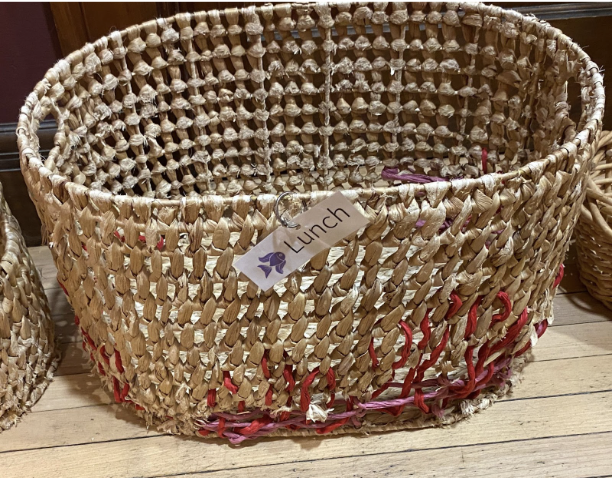Enough (Pt 2): An aesthetic project

In this essay, I continue the conversation about Enough, explaining how it is an aesthetic project, shaping how children make judgements about nature and material objects.
A continuing conversation
In a previous essay, I introduced the project of Enough. The project is premised on the understanding that there are limits to what humans can take from the earth without profoundly harmful consequences. For those of us in upper income brackets globally, this means learning to use less and share more. For those of us involved in raising the next generation, it involves socializing children in a non-coercive manner towards considered and ethical consumption preferences.
Twenty years ago, a parent of a kindergartener that I was teaching told me she had found her daughter trying to cut off the top half of her mitten. When asked about this seeming act of destruction, her daughter explained that she wanted gloves like her teachers had. Indeed, my colleague Heidi Given and I both wore mittens with fold-down flaps allowing for exposed fingers (making note-taking outside easier). We adults are involved in socializing children’s preferences even when we don’t know it.
In the initial essay, I explained that Enough is not a monk-like ascetic project. Sharing this essay at Newtowne led to two conversations, one with my fellow teachers and another with a group of parents. These conversations have led me to the conclusion that, while this is not an ascetic project, Enough is an aesthetic project. By aesthetic I mean what is considered beautiful, worthy, and important; what has value. And while we cannot mandate children’s aesthetic judgements, we certainly have a role in shaping the tastes and preferences of the next generation.
In this essay, I discuss two areas of aesthetics. First, judgments about what is beautiful and valued in the natural world. Then, in the consumer world, evaluations about the reused and mended.
What we value in nature
The conversation with parents began with my summarizing the initial Enough article. I then asked what ideas connected with them. One mother shared how fellow gardeners often talked about rabbits and dandelions as the enemy. While she appreciated the desire to keep flowers and veggies untouched, she worried about the message her son was overhearing about these parts of nature.
Listening to her comments, my mind turned to Peter Del Tredici’s Wild Urban Plants of the Northeast: A Field Guide. Del Tredici explains:
A weed is any plant that grows by itself in a place where people do not want it to grow. The term is a value judgment that humans apply to plants we do not like, not a biological characteristic. Calling a plant a weed gives us license to eradicate it.
He goes on to explain that:
When it comes to spontaneous urban plants, people's complaints are usually aesthetic (the plants are perceived as ugly signs of blight or neglect) or security related (they shield elicit human activity or provide habitat for vermin).
Indeed, the plants that are able to survive and thrive in urban environments–on cracks in the pavement, in the soil of vacant lots, on the rooftops of abandoned buildings–are part of a fascinating story of natural and cultural history. Their ability to flourish under harsh conditions tells an inspiring tale of adaptability.
What Del Tredici writes about plants can easily be applied to animals. Consider the pigeon. While sometimes derided as “rats with wings”, they are fascinating creatures. Did you know that pigeons:
- breed year round, even in cold conditions?
- produce crop milk in their throat pouch for their babies, unlike most other birds, who feed their young what they catch?
- can fly as fast as 90 miles per hour?
- are active participants in scientific research– not by being experimented on– but by helping carry scientific equipment in air pollution studies?
I highlight pigeons because they are one of the birds that children at Newtowne, who live in a city, are likely to encounter. A close look reveals that they are a very attractive critter.
What if, when we saw pigeons, we adults expressed admiration and excitement? What if we shared some of this information about pigeons and admired their resilience (young children are fascinated by fast animals)? What if the pigeon took a place in the pantheon of my critters studied in early childhood classrooms?
Another what if: what if schools and centers let their lawns go with a riot of dandelions in the spring? That would be a beautiful sight indeed. And if they won’t be fought with herbicides, their seeds would be available for children to play with.
What if bunnies were portrayed as friendly adversaries instead of the enemy?
These are aesthetic decisions.
The reused and mended
In the conversation with parents, I also asked about what teachers and families might do at Newtowne in service of the project of Enough. The question led to a robust conversation about a clothes swap, perhaps with children being involved in the organization. There was excitement about this potential endeavor, and our director Caitlin Malloy offered a caution: making sure a swap did not inculcate a “savior mentality” among children whose families might see donating clothes as an act of charity.
Caitlin's concern is an important one, and its source is partially aesthetic: that generally what is new and shiny is more valued than the old and used. But what if snow pants and a T-shirt were legacy items; that wearing an item of a “big kid” held currency. What if a worn look or a knee patch conferred a pair of pants with a sense of beauty and prestige? In that case all families would see the swap as a resource for them–not just to give but to take. In this vein, there are groups bringing the ethos of repair in fashion into K through 12 education.
Valuing mending and repair was a point teacher Danielle Hart brought up in the conversation among Newtowne’s faculty. She wondered about setting up a classroom fix-it station where broken tools and materials could be repaired instead of discarded and replaced. To this point, Teaching Fellow Elena Lapa had just mended a basket for her Purple Fish students’ lunch boxes. Rather than purchasing a new basket, she made the old one into something even more attractive.
Pushing the aesthetic value of the old and the used further, what if broken items were candidates for creating something else; something of beauty? My friend Flossie Choa has a project called Transformative Repair. Inspired by the Japanese art of kintsugi, Flossie worked with middle school teachers to create activities to help their students imagine how what is broken can become something different and beautiful. It is easy to imagine young children being involved in such endeavors.
Wisdom as “the art of the minimums”
A friend was in Japan in March of 2013 when a devastating earthquake and tsunami hit. She tells of being in a convenience store later that day, and instead of the stock flying off the shelves, of the customers buying only what they absolutely needed, taking care that everyone in the store was able to procure the essentials.
Wendell Berry defines wisdom as “the art of the minimums” in other words, to know when one has enough. Those customers in the convenience store were practicing the art of the minimums in a social sense which I find admirable. We also need to learn the art of the minimums in an ecological sense. Aesthetics have an important role here.
The cultivation of wisdom; isn’t that what education is all about?
